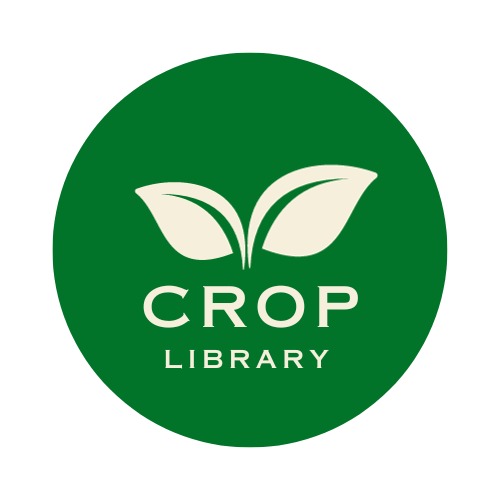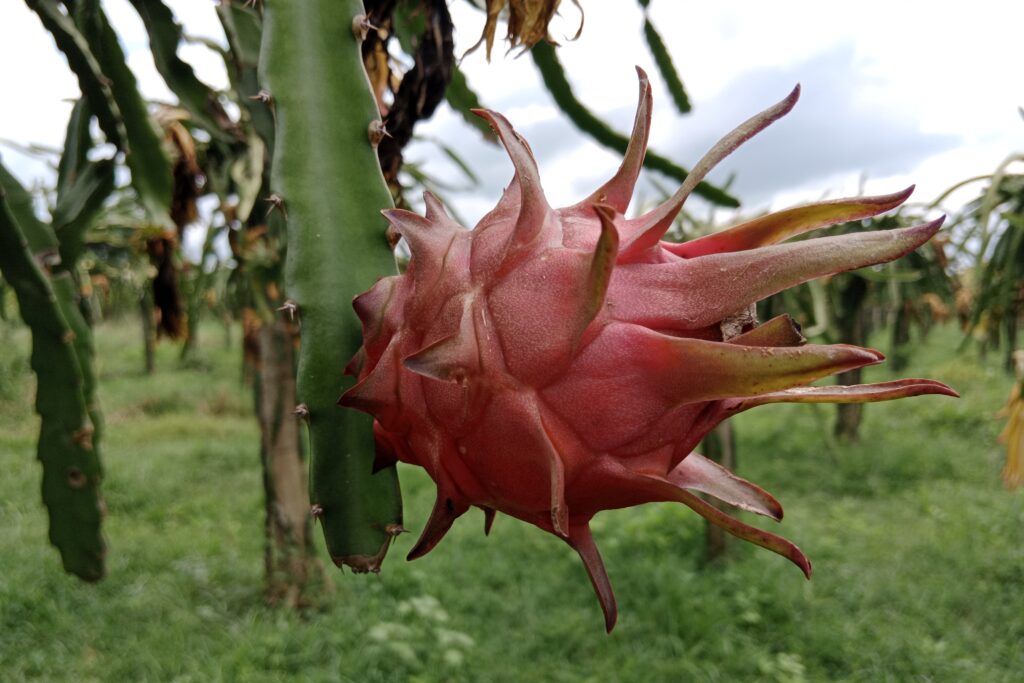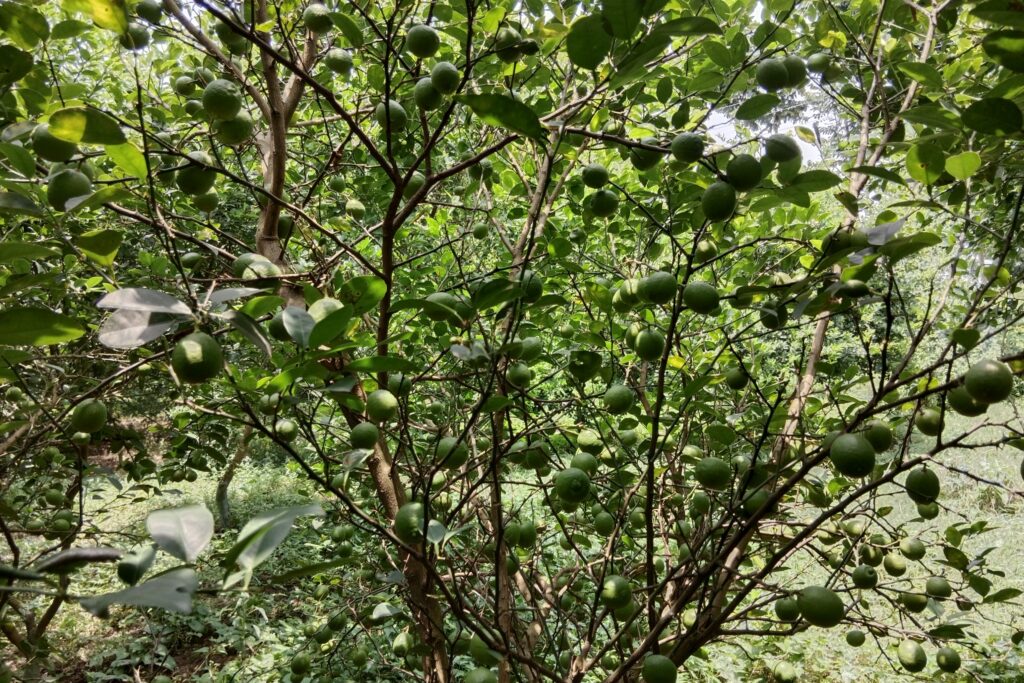Curry Leaf Farming
Curry leaf is an aromatic, perennial shrub native to the Indian subcontinent. Its leaves are a fundamental ingredient in South Asian cuisines and are gaining popularity globally for their medicinal properties. Commercial cultivation can be highly profitable due to consistent demand.
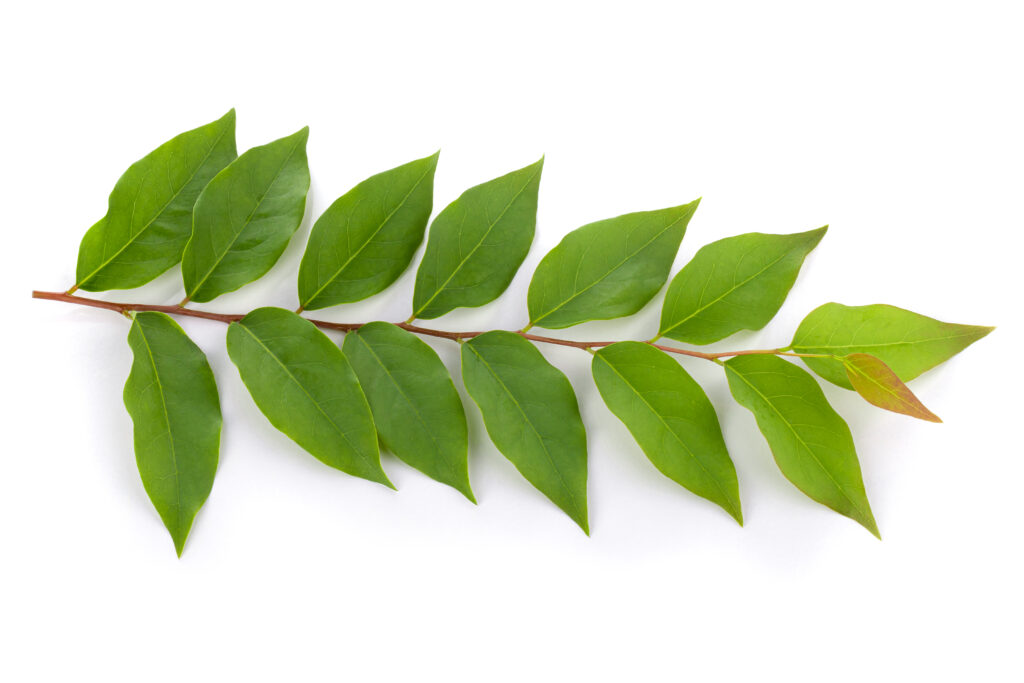
Curry leaf farming profit per acre offers an attractive long-term return despite the high initial investment of around NRs. 130,000, mainly spent on planting materials and establishment. The enterprise becomes highly profitable from the fourth year onward, with the most rewarding period occurring between the fourth and tenth years, when the farm can earn a steady annual income exceeding NRs. 192,000 against maintenance costs of just NRs. 40,000, resulting in an impressive annual profit of over NRs. 152,000.
The break-even point is typically reached by the fourth year, which aligns with the growth pattern of perennial crops. Over a 15-year span, the farming venture can generate a total net profit of about NRs. 1,612,250 on a cumulative investment of NRs. 690,000, reflecting an outstanding return on investment of over 230%.
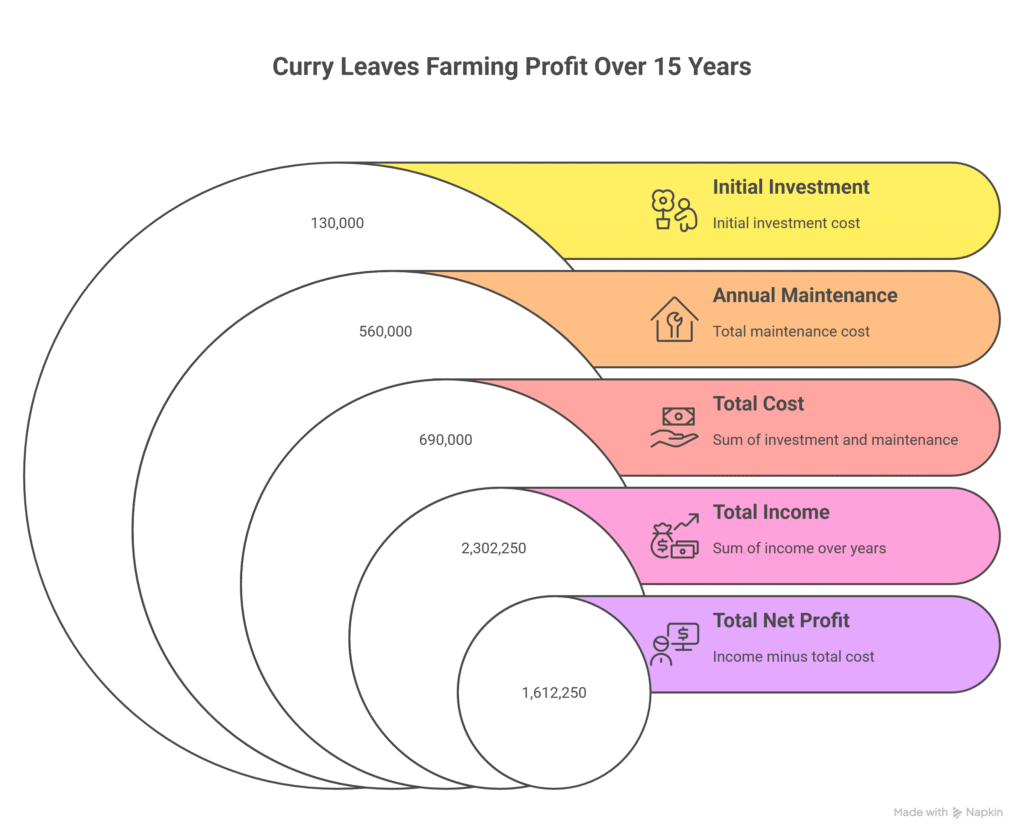
However, this profitability largely depends on stable yields and market price factors such as pest infestation or price fluctuations may reduce returns, whereas favorable market conditions can significantly boost overall earnings.
Land Preparation
The land should be ploughed thoroughly 2-3 times to achieve a fine tilth—a loose, crumbly soil structure that is ideal for root development. This process helps in breaking up clods, aerating the soil, and incorporating any existing organic matter or previous crop residues. After ploughing, the field is leveled to ensure uniform water distribution and to prevent waterlogging in certain patches.
Soil Type
The crop grows best in fertile, loamy soils that allow good drainage, with an optimal soil reaction between pH 5.6 and 7.5. Although it can be cultivated in sandy or lateritic soils, these conditions demand additional organic inputs and more frequent watering. In contrast, soils that are heavy in clay or that retain excess moisture are unsuitable, as they often result in stunted plants and root diseases.
Climatic Requirements
Curry leaf plants perform best in warm subtropical and tropical regions, where temperatures generally range between 26°C and 37°C (79°F to 99°F). They are highly frost-sensitive and do not survive freezing conditions. The crop adapts well to annual rainfall between 500 and 1500 mm and benefits from supplemental irrigation. However, when high humidity coincides with cooler temperatures, the plants become more prone to fungal infections.
Major Cultivars
Unlike most cultivated crops, curry leaf does not have widely established commercial varieties. Instead, selections are usually made for desirable traits such as leaf aroma and quality, while farmers commonly propagate local strains that show strong yields and resistance to diseases.
| Feature | Regular/Dwarf Type | Gamthi Type |
| Aroma | Strong aroma | Stronger, superior aroma |
| Growth Habit | Bushy | More compact |
| Leaf Description | Not specified (standard) | Broader & darker green leaves |
| Growth Rate | Standard | Slower |
| Suitability | High-density planting | Preferred for high essential oil content |
Propagation
Curry leaf is usually propagated vegetatively to preserve important traits of the mother plant, such as aroma and yield. The most common approach is through stem cuttings. Semi-hardwood cuttings, 15–20 cm long with 3–4 nodes, are taken from healthy, high-yielding plants that are 8–12 months old.
The lower leaves are removed, and the cut base is treated with a rooting hormone like IBA to encourage root formation. Although seed propagation is possible, it is less favored in commercial cultivation because it introduces genetic variation, delays fruiting by 2–3 years, and often produces plants with weaker aroma than the parent.
Seedling Rate per Acre
An acre of curry leaf cultivation requires approximately 2,810 stem cuttings as planting material.
Nursery Management
For nursery management, raised beds about one meter wide and of suitable length are prepared in a shaded, protected location. Treated cuttings may be planted directly in these beds or in protrays filled with a sterile potting mixture of soil, sand, and farmyard manure.
The beds are kept moist with regular light irrigation, and mulching with dry grass helps to conserve moisture. Within 6–8 weeks, the cuttings usually form roots and can be transplanted once they show healthy root growth and fresh leaf development.
Planting
a). Planting Season
The ideal planting season for transplanting is at the onset of the monsoon (June–July) to make use of natural rainfall, though under irrigated conditions it can also be carried out in spring (February–March).
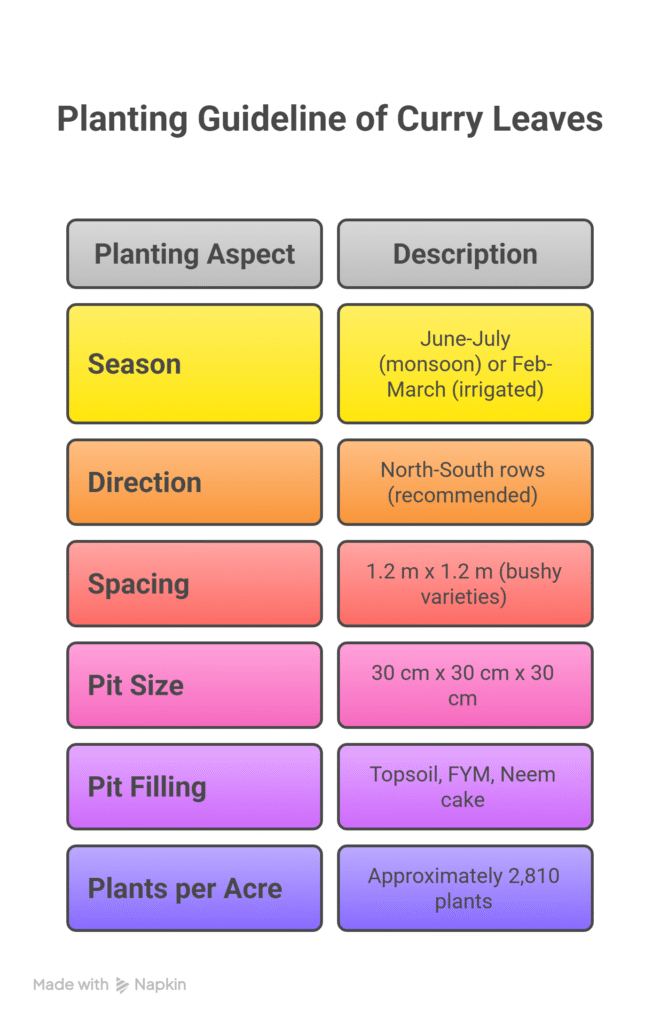
b). Planting Direction
There is no specific directional requirement, but the layout of the field (rows running North-South) allows for better sunlight exposure.
c). Spacing
For bushy varieties, whether regular or dwarf, a spacing of 1.2 m × 1.2 m is recommended.
d). Pit Preparation
Pits of size 30 cm x 30 cm x 30 cm are dug at the marked spots.
e). Pit Filling & Planting Method
Each pit is filled with a mixture of topsoil, 5-10 kg of well-decomposed Farm Yard Manure (FYM), and 100 grams of Neem cake. The healthy seedling from the nursery is placed in the center of the pit, the soil is filled back and pressed firmly. It is then watered immediately.
f). Number of Plants per Acre
Based on a spacing of 1.2 m x 1.2 m, approximately 2,810 plants can be accommodated per acre.
Intercropping
For the first two years, farmers may intercrop short-duration plants like legumes, vegetables, or coriander in the spaces between curry leaf plants. This practice provides supplementary income and helps manage weeds effectively.
Irrigation
Young saplings need to be watered frequently, about every 2–3 days during the early months, to help them establish well. Once matured, irrigation can be scheduled less often—roughly every 7–10 days in summer and 15–20 days in winter, depending on soil and weather conditions. Adequate watering is especially vital during leaf flushing and after harvesting to encourage fresh growth, and drip systems are strongly advised for conserving water.
Fertilizer and Manure
The curry leaf plant thrives when nourished with organic manure, showing a particularly vigorous response to its application. Initially, at the time of planting, a basal dose consisting of 5-10 kg of Farm Yard Manure (FYM) along with 100g of Neem cake should be incorporated into each pit.
For an established, grown plant, an annual regimen is recommended, which includes applying 10-15 kg of FYM or compost, 500g of Neem cake, and specific chemical fertilizers providing 100g of Nitrogen (N), 50g of Phosphorus (P₂O₅), and 50g of Potash (K₂O) per plant.
To maximize effectiveness, this full annual dose should be split into two equal applications: the first at the onset of spring in February-March and the second after the monsoon rains in September-October. For each application, the fertilizers should be placed in a ring around the plant, thoroughly mixed into the soil, and followed by irrigation to ensure proper nutrient uptake.
Weed Control
Effective weed control is crucial, particularly during the initial establishment stage in the first year, which necessitates regular manual weeding or hoeing to keep the planting basin free of competing vegetation; subsequently, a more sustainable and multi-beneficial approach can be achieved through mulching, where applying a layer of organic material such as dry leaves or straw, or even using black plastic mulch, around the plants effectively suppresses future weed growth, simultaneously conserves vital soil moisture, and in the case of organic mulches, gradually adds valuable organic matter back into the soil as it decomposes.
Interculture Operation
To ensure a healthy structure and high leaf yield, curry leaf plants require diligent training and pruning. The initial training involves allowing the main stem to reach about one meter in height while removing all side shoots up to that point, which directly contributes to building a strong and substantial trunk.
Once this framework is established, the focus shifts to the crucial operation of pruning. For optimal results, plants are pruned back to the one-meter mark after their first harvest to encourage a bushy form through lateral branching. This is followed by consistent, light pruning after every harvest, which serves to manage the plant’s shape, remove unhealthy wood, and stimulate new flushes of the valuable tender leaves.
Flowering and Fruit Management
Flowering in curry leaf plants generally begins in the second year, and although the flowers are fragrant, allowing them to set fruit diverts the plant’s energy away from leaf development. For farmers primarily cultivating the crop for leaf yield, it is recommended to pinch off flower panicles as soon as they appear, a practice known as de-blossoming. This technique ensures that the plant’s nutrients are redirected towards vegetative growth rather than fruit production, thereby promoting vigorous growth and enhancing both the quantity and quality of leaf yield.
Pest and Disease Management
Common Pests
Citrus Butterfly Caterpillar
The larvae of the citrus butterfly are one of the most frequent pests on curry leaf plants. They chew on young, tender foliage, which can slow down plant development and reduce overall growth. Light infestations can be managed by manually collecting and removing the caterpillars.
In cases of heavy attack, spraying neem-based formulations such as Neem oil at 5 ml per liter of water or Azadirachtin 1500 ppm at 2 ml per liter of water is recommended for effective control.
Psyllid
Psyllids are tiny sap-feeding insects that cause noticeable leaf curling, distortion, and a decline in plant growth and leaf quality. When the infestation is mild, applying neem oil at 5 ml per liter of water can suppress their numbers. For more severe cases, chemical insecticides like Dimethoate 30 EC at 2 ml per liter of water or Imidacloprid 17.8 SL at 0.5 ml per liter of water may be applied to achieve reliable control.
Scale Insects
Scale insects appear as small brown or whitish patches on leaves and stems. By continuously sucking sap, they gradually weaken the plant and reduce productivity. They can be managed by spraying horticultural mineral oil (2%) or neem oil at 5 ml per liter of water, which suffocates the insects. Under heavy infestations, chemical options such as Malathion 50 EC at 2 ml per liter of water or Chlorpyriphos 20 EC at 2 ml per liter of water may be used to reduce their population.
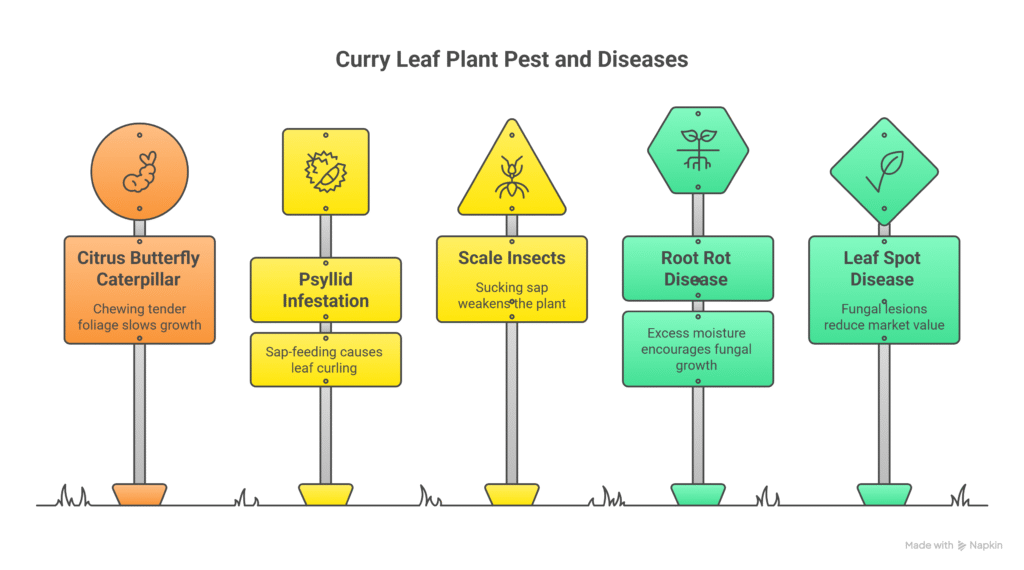
Common Diseases
Root Rot
Root rot in curry leaf plants commonly develops under conditions of excess moisture and poor drainage, which encourage the growth of soil-borne fungi such as Phytophthora and Pythium. Affected plants show symptoms like yellowing leaves, wilting, and, if untreated, may eventually die.
Preventive measures include improving field drainage, avoiding over-irrigation, and applying fungicide drenches in nursery soil. In established plants, the disease can be managed by drenching the root zone with Copper Oxychloride at 3 g per liter of water or Carbendazim 50 WP at 1 g per liter of water to suppress fungal activity.
Leaf Spot
Leaf spot is a frequent fungal issue in curry leaf crops, identified by small brown to black circular lesions that expand over time and reduce the market value of the leaves. The disease spreads more quickly under humid weather conditions.
To control it, spraying a 1% Bordeaux mixture (prepared by mixing 1 kg copper sulfate and 1 kg lime in 100 liters of water) is effective. Alternatively, Copper Oxychloride at 2.5 g per liter of water or Mancozeb 75 WP at 2 g per liter of water may be applied at intervals of 10–15 days to check the spread of infection.
Harvesting
The first harvest of curry leaf can be done 8–12 months after planting, and with proper care, the plant can be harvested 3–4 times a year. Harvesting is usually carried out by hand-picking the fresh, tender leafy shoots, as mature, dark green leaves tend to be less aromatic. For best results, shoots are cut about 10–15 cm from the tip, and the practice is ideally done in the early morning to retain maximum aroma and quality.
Yield
In the initial two years, curry leaf plantations generally provide modest harvests, averaging between 500 and 800 kilograms of fresh leaves per acre annually. From the third year onward, once the crop is well established and properly managed, production increases significantly, reaching around 2,000 to 2,500 kilograms per acre each year. Full maturity is typically attained within three to five years. Among the different varieties, Gamthi stands out despite yielding fewer leaves, as its strong fragrance and superior quality make it highly desirable in the market, often commanding a higher price than other types.
Cost of Investment per acre for Curry Leaves
| S.N. | Categories | Cost of Investment (NRs.) |
| 1 | Land Preparation | 15,000 |
| 2 | Planting Materials (Stem Cuttings) | 70,000 |
| 3 | Planting | 8,000 |
| 4 | Fertilizers and Manure | 12,000 |
| 5 | Irrigation | 10,000 |
| 6 | Weed Control (Pre & Post-Emergence) | 2,000 |
| 7 | Pest & Disease Control | 4,000 |
| 8 | Harvesting | 4,000 |
| 9 | Miscellaneous Costs | 5,000 |
| Total | 130,000 |
Annual Maintenance Cost Per Acre for Curry Leaves
The annual maintenance cost for curry leaf farming from the second year onward is estimated at around NRs. 40,000 per acre per year. This recurring expense primarily covers activities such as applying organic and chemical fertilizers, irrigation management, weeding operations, pest and disease control, pruning of plants to maintain healthy growth, and harvesting of leaves.
It may also include minor costs for labor, transportation, and field upkeep. Compared to the initial establishment cost, the annual maintenance cost is relatively low, yet it ensures consistent yield and high-quality leaf production throughout the productive lifespan of the plantation.
Income Per Acre from Curry Leaves Farming
| Year | Estimated Yield / Acre (Kg) | Market Price (NRs. / Kg) | Total Annual Income (NRs.) |
| 1st Year | 420 | 50 | 21,000 |
| 2nd Year | 1,120 | 50 | 56,000 |
| 3rd Year | 2,100 | 50 | 105,000 |
| 4th – 10th Year (Per Year) | 3,500 | 55 | 192,500 |
| 11th – 15th Year (Per Year) | 2,810 | 55 | 154,550 |
| 16th Year Onward (Per Year) | 2,000 | 60 | 120,000 |
Analysis of Curry Leaves Farming Profit Per Acre
This analysis projects the profit over a 15-year period, which covers the establishment phase and the high-yielding prime years.
A). Cost Analysis Over 15 Years
| Cost Type | Calculation | Amount (NRs.) |
| Initial Investment (Year 0) | — | 130,000 |
| Annual Maintenance (Years 2-15) | NRs. 40,000/year for 14 years | 560,000 |
| Total Cost over 15 Years | 130,000 + 560,000 | 690,000 |
B). Income Analysis Over 15 Years
| Year | Annual Income (NRs.) | Cumulative Income (NRs.) |
| 1 | 21,000 | 21,000 |
| 2 | 56,000 | 77,000 |
| 3 | 105,000 | 182,000 |
| 4 to 10 (7 years) | 192,500 / year | 1,347,500 |
| 11 to 15 (5 years) | 154,550 / year | 772,750 |
| Total Income (Years 1-15) | 21k + 56k + 105k + 1,347.5k + 772.75k | 2,302,250 |
C). Profit & Return Analysis
| Metric | Calculation | Amount (NRs.) |
| Total Net Profit (Years 1-15) | Total Income – Total Cost | 2,302,250 – 690,000 = 1,612,250 |
| Average Annual Profit (Years 4-15) | Total Profit from Prime Years / 12 | 134,354 |
| Break-Even Point | When Cumulative Income > Total Cost Incurred | Sometime in the 4th Year. |
Sources
Food and Agriculture Organization (FAO)
University of California Agriculture & Natural Resources (UC ANR)
European Plant Protection Organization (EPPO)
Punjab Agricultural University (PAU)
Tamil Nadu Agriculture University (TNAU) – Agritech portal
Indian Council of Agricultural Research (ICAR)
Nepal Agricultural Research Council (NARC)
U.S. Department of Agriculture (USDA).
Ministry of Agriculture and Livestock Development (Nepal)
Disclaimer: This crop farming profits assume optimal conditions. Actual results may vary depending on climate, market prices, and farm management practices.
